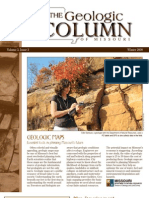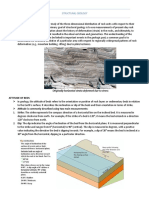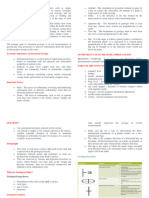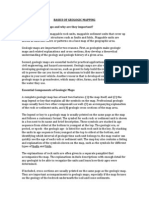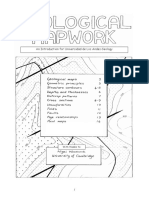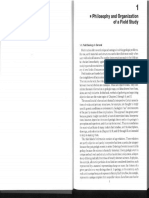1/27/2023
Lab. No. 1-2 2023
Introduction to Geological Maps
• A key goal of structural geologists is to understand the three
dimensional (3D) geometry of rock layers.
• Geological maps are one of the most fundamental data sources in
all fields of geology.
• A geological map is a two dimensional (2D) representation of
geological features on the Earth’s surface.
• Geological maps show the distribution, known and inferred, of
rock units on the Earth’s surface, the nature of contacts
separating them (e.g., stratigraphic contacts, faults,
unconformities …), and are the basic way to analyze the geometry
of deformed rock layers “structures”.
• A geological map consists of a topographic map that show where
different rock units occur at or just below the ground surface.
Ass. Prof. Dr. Jamal Doski
• Geological maps show the orientations of bedding surfaces,
faults, cleavage, joints, striations, ….
• Geological maps come in a variety of scales depending on the
amount of detail needed for different purposes.
• Geological maps usually include
stratigraphic columns and one or
more cross-sections.
• Stratigraphy columns show the
different formations on the map
in the order of deposition, with
the oldest at the bottom and
youngest at the top. They also
show their thicknesses and are
usually drawn to scale.
1
� 1/27/2023
• Geological maps are a projection of geologic features that lie on an
irregular “spherical” surface of the earth onto a map. Therefore,
when you measure a distance on a map (i.e., a map distance or
map length), it is a horizontal distance not the longer distance that
you actually travel along a slope (i.e., the slope distance).
𝒄𝒉𝒂𝒏𝒈𝒆 𝒊𝒏 𝒆𝒍𝒆𝒗𝒂𝒕𝒊𝒐𝒏
𝐭𝐚𝐧 𝜶 = , 𝜶 = 𝒔𝒍𝒐𝒑𝒆 𝒂𝒏𝒈𝒍𝒆
𝒎𝒂𝒑 𝒅𝒊𝒔𝒕𝒂𝒏𝒄𝒆
𝑺𝒍𝒐𝒑𝒆 𝒅𝒊𝒔𝒕𝒂𝒏𝒄𝒆 𝟐 = 𝒄𝒉𝒂𝒏𝒈𝒆 𝒊𝒏 𝒆𝒍𝒆𝒗𝒂𝒕𝒊𝒐𝒏 𝟐 + 𝒎𝒂𝒑 𝒅𝒊𝒔𝒕𝒂𝒏𝒄𝒆 𝟐
𝑺𝒍𝒐𝒑𝒆 𝒅𝒊𝒔𝒕𝒂𝒏𝒄𝒆 = 𝒄𝒉𝒂𝒏𝒈𝒆 𝒊𝒏 𝒆𝒍𝒆𝒗𝒂𝒕𝒊𝒐𝒏 𝟐 + 𝒎𝒂𝒑 𝒅𝒊𝒔𝒕𝒂𝒏𝒄𝒆 𝟐
Geologic cross-sections
• In order to provide a third dimension, draw one or more vertical
“slices” sections through a map area.
• Geologic cross-sections are constructed from geologic maps, well
data, seismic lines, and other geophysical data.
• Geologic cross-sections show the subsurface (and often the
above-surface) geology, as predicted from the features mapped at
the surface, such as fold-fault geometries.
• Most cross-sections are drawn to true scale, where the horizontal
scale is the same as the vertical scale.
• Drawing realistic geologic cross-section is very difficult because
the locations and compass-measured orientations of bedding,
contacts, faults, and other structures hold only for the surface of
the area, and it cannot be given for any depth below the surface.
Therefore, the subsurface geology must be drawing in a way that
is everywhere consistent with the geologic control at the surface
and the style of deformation seen in the surface area.
2
� 1/27/2023
How to draw a geologic cross-section?
Step 1:
Determine the line along which to draw the section. The line of
section should be:
a- Representative of the study area
b- Perpendicular to the major structural feature of the area
(e.g., large scale folds or faults)
c- Cross as many structural features as possible
d- Run through areas with the most data readings
Step 2:
Draw horizontal and vertical axes with a suitable scale based on the
topographic values.
Step 3:
Transfer the topographic information from the map to the section.
Project the height of each topographic contour, where it crosses the
line of section, on to the section and draw in the topography.
Step 1 and 2 Step 3
3
� 1/27/2023
Step 4:
Transfer the lithological boundaries (contacts), faults, unconformities
and other structures on to the cross-section in the same way.
Step 5:
Transfer bedding readings on to the section. Plot the readings at
which they occur, above or below the topographic profile of the
cross-section.
Step 6:
Using the bedding readings as a guide, draw in the lithological
boundaries both above and below the surface. Geology extended
above the topography is shown by dashed lines. When drawing the
section always consider what is geologically acceptable for the
layers, e.g., sudden changes in a unit’s thickness or dip should be
justifiable.
Step 4 and 5 Step 6
4
� 1/27/2023
Examples of Topographic Maps
5
� 1/27/2023
Examples of Geologic Maps
Basic technique for drawing a geologic cross-section perpendicular to the strike of
the bedding. Arrows show transfer of attitudes from map to section. Dashed lines
represent beds that have been eroded away.
6
� 1/27/2023
a) Geological map with elevation contours (in meters).
b) Cross-section along line X-Y
a) 3D diagram and map view of upright, horizontal folds.
b) 3D diagram and map view of upright, plunging folds.
7
� 1/27/2023
a) Geologic map of upright, horizontal folds in sedimentary sequences,
transected by a westward drainage stream valley.
b) East-west section across the map.
8
� 1/27/2023
Stratigraphic thickness from maps
• True thickness ( t ) : the perpendicular distance between the
parallel planes bounding a bed, as displayed on any section
perpendicular to these planes.
• Apparent thickness ( t` ) : the distance between the bounding
planes measured on oblique sections. The apparent thickness is
always greater than true thickness.
• Outcrop width ( w ) : the strike-normal distance between the
traces of the parallel bounding planes measured at the earth’s
surface. It may be measured horizontally or on an incline.
True thickness t
Apparent thickness t`
Outcrop width w
Depth d
9
� 1/27/2023
Effects of dip of beds and steepness of topography on width of
outcrop on the map
• The width of outcrop on a map is affected by the dip of beds and
the steepness of topography.
• All the beds in figures below have the same thickness.
• As the dip decreases from steeply dipping in (a) to gently dipping
in (c), the outcrop on the map becomes wider.
• In (d), the beds have the same dip, but the topography varies.
Where the topography is steepest on the hillside the outcrop is
narrow, but where the topography is horizontal along the hill top
the outcrop is wider.
10
� 1/27/2023
Geological history
• Geologists can extract more information from geologic maps,
such as the geological history of an area and the characteristics
of geological structures.
• The geological history includes:
1- Describing the geometry of rock units and geological
structures.
2- The time sequence by which the geometry formed and
developed.
3- The date of events in terms of the geological time scale.
4- Erosion is an important geologic process in the rock units
that plays a major role in modifying the geologic expression
“outcrops” of earth surface “topography”.
11
� 1/27/2023
• Some geological features are of great assistance in dating the
periods of structures deformation, such as unconformities.
• Unconformities represent a break in deposition and a period of
uplift and erosion.
Types of unconformities
The following criteria are self-evident for events in chronological
sequence:
1- Folds are younger than the folded rocks.
2- Fractures (e.g., faults, joints, …) are younger than the rocks
they cut.
3- Metamorphism is younger than the rock it affects.
4- The erosion represented by an unconformity is younger than
the underlying rocks and older than the overlying ones.
5- Igneous rocks are younger than host rocks. A similar rule holds
for other types of intrusions such as salt domes.
12
� 1/27/2023
Symbols used on geologic maps and sections
Normal fault
Reverse fault
Strike-slip fault
Anticline
Syncline
13





